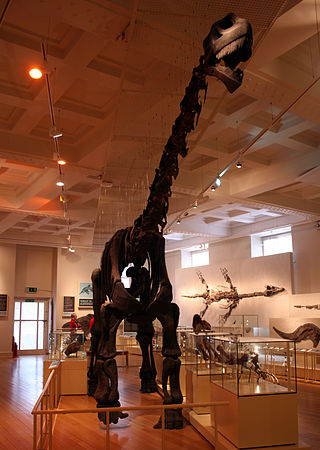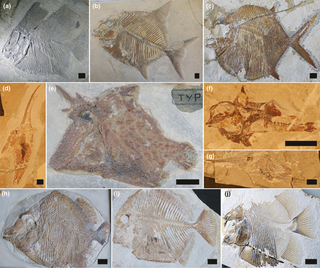Liopleurodon is an extinct genus of carnivorous pliosaurid pliosaurs that lived from the Callovian stage of the Middle Jurassic to the Kimmeridgian stage of the Late Jurassic period. The type species is L. ferox, which is probably the only valid species. Some studies also include the second species L. pachydeirus, but this latter is considered as a probable junior synonym of L. ferox due to its lack of viable diagnosis. As the holotype specimen of L. ferox consists of a single tooth preserving questionable distinctive features, recent studies therefore recommend the necessary identification of a neotype in order to preserve the validity of the genus. Numerous fossil specimens attributed to Liopleurodon, even including numerous skeletons, have been discovered in Europe, Russia, and Mexico. Other additional species were even proposed, but these are currently seen as coming from other pliosaurid genera.

Caturus is an extinct genus of predatory marine fishes in the family Caturidae in the order Amiiformes, related to modern bowfin. It has been suggested that the genus is non-monophyletic with respect to other caturid genera.

Dakosaurus is an extinct genus of crocodylomorph within the family Metriorhynchidae that lived during the Late Jurassic and Early Cretaceous. It was large, with teeth that were serrated and compressed lateromedially. The genus was established by Friedrich August von Quenstedt in 1856 for an isolated tooth named Geosaurus maximus by Theodor Plieninger in 1846. Dakosaurus was a carnivore that spent much, if not all, its life out at sea. The extent of its adaptation to a marine lifestyle means that it is most likely that it mated at sea, but since no eggs or nests have been discovered that have been referred to Dakosaurus, whether it gave birth to live young at sea like dolphins and ichthyosaurs or came ashore like turtles is not known yet. The name Dakosaurus means "biter lizard", and is derived from the Greek dakos ("biter") and σαῦρος -sauros ("lizard").

Echinodon is a genus of heterodontosaurid dinosaur that lived during the earliest Cretaceous of southern England and possibly western France in the Berriasian epoch. The first specimens were jaw bones named Echinodon becklesii by Sir Richard Owen in 1861, and since their original description only additional teeth have been discovered. The specific name honours collector Samuel Beckles who discovered the material of Echinodon and many other taxa from across England, while the genus name translates as "prickly tooth" in reference to the dental anatomy of the taxon.

Cetiosaurus meaning 'whale lizard', from the Greek keteios/κήτειος meaning 'sea monster' and sauros/σαυρος meaning 'lizard', is a genus of herbivorous sauropod dinosaur from the Middle Jurassic Period, living about 168 million years ago in what is now Britain and probably France.

Machimosaurus is an extinct genus of machimosaurid crocodyliform from the Late Jurassic and Early Cretaceous. The type species, Machimosaurus hugii, was found in Switzerland. Other fossils have been found in England, France, Germany, Portugal, Switzerland and Tunisia. Machimosaurus rex is the largest named teleosauroid and thalattosuchian, with an estimated length of up to 7.15 m (23.5 ft). Machimosaurus is the largest known crocodyliform of the Jurassic.

Lepidotes is an extinct genus of Mesozoic ray-finned fish. It has long been considered a wastebasket taxon, characterised by "general features, such as thick rhomboid scales and, for most of the species, by semi-tritorial or strongly tritorial dentition". with dozens of species assigned to it. Fossils attributed to Lepidotes have been found in Jurassic and Cretaceous rocks worldwide. It has been argued that Lepidotes should be restricted to species closely related to the type species L. gigas, which are only known from the Early Jurassic of Western and Central Europe, with most other species being not closely related, with other species transferred to new genera such as Scheenstia.Lepidotes belongs to Ginglymodi, a clade of fish whose only living representatives are the gars (Lepisosteidae). The type species L. gigas and close relatives are thought to be members of the family Lepidotidae, part of the order Lepisosteiformes within Ginglymodi, with other species occupying various other positions within Ginglymodi.

Aspidorhynchus is an extinct genus of predatory ray-finned fish from the Middle Jurassic to the earliest Cretaceous. Fossils have been found in Europe, Antarctica and the Caribbean.

Protosphyraena is a fossil genus of swordfish-like marine fish, that thrived worldwide during the Cretaceous period (Albian-Maastrichtian). Fossil remains of this taxon are mainly discovered in North America and Europe, and potential specimens are also known from Asia, Africa and Australia. Its fossils are best known from the Smoky Hill Member of the Niobrara Chalk Formation of Kansas.

Ceratodus is an extinct genus of freshwater lungfish that was found worldwide during the Mesozoic Era. It has been described as a "catch all", and a "form genus" used to refer to the remains of a variety of lungfish belonging to the extinct family Ceratodontidae. Fossil evidence dates back to the Early Triassic. A wide range of fossil species from different time periods have been found around the world in places such as the United States, Argentina, Greenland, England, Germany, Egypt, Madagascar, China, and Australia. Ceratodus is believed to have become extinct sometime around the beginning of the Eocene Epoch.

Belonostomus is a genus of prehistoric ray-finned fish that was described by Louis Agassiz in 1844. It is a member of the order Aspidorhynchiformes, a group of fish known for their distinctive elongated rostrums.

Pycnodontiformes is an extinct order of primarily marine bony fish. The group first appeared during the Late Triassic and disappeared during the Eocene. The group has been found in rock formations in Africa, Asia, Europe, North and South America.

Anomoeodus is an extinct genus of prehistoric marine ray-finned fish belonging to the family Pycnodontidae. This genus primarily lived during the mid-to-late Cretaceous period, ranging from the Albian to the very end of the Maastrichtian age, and possibly into the Danian. The first fossils of Anomoeodus were described by Louis Agassiz in 1833, although they were described under Pycnodus. Some studies have recovered it as a wastebasket taxon.

Coelodus is an extinct genus of marine and possibly freshwater pycnodont fish. It contains only one definitive species, C. saturnusHeckel, 1854, from the Late Cretaceous of Slovenia. Other species from the Late Jurassic to the Eocene have also been attributed to this genus based on isolated dental elements, but their assignment to Coelodus is uncertain, and this genus likely represents a non-monophyletic wastebasket taxon. A potential diagnostic trait is a prearticular tooth row with three regular highly elongated teeth.

Cylindracanthus is an extinct, enigmatic genus of marine ray-finned fish with fossils known throughout North America, Europe, Asia and Africa from the Late Cretaceous to the late Eocene, with potential Oligocene records and a possible Miocene record also known. It is exclusively known from its distinctive partial remains, which are long cylindrical bony spines that are usually considered rostrum fragments, as well as some associated teeth. These spines are abundant & widespread throughout this timespan, and are useful indicators of a nearshore marine environment, but the taxonomic identity of the fish is still highly uncertain and debated.
Eomesodon is an extinct genus of prehistoric marine pycnodont fish.

Enchelyolepis is an extinct genus of prehistoric marine ray-finned fish known from the Late Jurassic and Early Cretaceous of Europe. It was a member of the Macrosemiidae, a family of ginglymodians distantly related to modern gars, and contains two species that were both previously described as species of Macrosemius.

Tinodon is an extinct genus of mammal. First described by the paleontologist Othniel Charles Marsh, it contains two recognized species: Tinodon bellus and T. micron. It is known from jaw and dental remains. Its taxonomic placement within the mammalian lineage remains uncertain, having been variously placed within and outside of the crown group Mammalia. It lived from the Late Jurassic to the Early Cretaceous, found in both North America and Europe. Its known habitats are believed to have ranged from semi-arid to arid.

The Helochelydridae are an extinct family of stem-turtles known from fossils found in North America and Europe spanning the Early to Late Cretaceous.

Coccolepididae is an extinct family of ray-finned fish, known from the Early Jurassic to Early Cretaceous, most of which were originally referred to the type genus Coccolepis. They had a widespread distribution, being found in North and South America, Australia, Asia and Europe. They are mostly known from freshwater environments, though several species have been found in marine environments. They are morphologically conservative, and have poorly ossified endo and exoskeletons, which usually results in poor preservation. This makes it difficult to distinguish species. They are generally small fish, with the largest known specimens reaching a length of 210 mm. Historically, they have been classified as members of “Palaeonisciformes”, a paraphyletic grouping of non-neopterygian fish, due to their plesiomorphic conservative morphology closely resembling those of many other groups of primitive fish. Some recent authors have suggested that they may belong to the order Chondrostei as relatives of the Acipenseriformes.


















